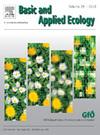水生猎物对河岸节肢动物捕食者的重要性综述
IF 3.5
2区 环境科学与生态学
Q2 ECOLOGY
引用次数: 0
摘要
水生资源可以成为河岸消费者的重要补贴。我们系统地回顾了河岸捕食者利用水生猎物的变化,并研究了新兴昆虫可用性的变化和差异是否影响河岸节肢动物捕食者群落。我们发现水生补贴是一些滨水节肢动物捕食者的主要食物来源。然而,水生猎物在饮食中的作用因捕食者群体和狩猎策略而异。滨水造网蜘蛛,尤其是水平造网蜘蛛,其饮食中水生昆虫的比例最高(70%)。然而,自由狩猎的蜘蛛和河滨甲虫也从这些补贴中受益匪浅。水生猎物的利用随离水距离的增加而减少,随出苗期的变化而变化,并受生境特征的影响。我们的综述还表明,河岸节肢动物捕食者的丰度和生物量可能受到水生补贴可用性变化的影响。这在河岸造网蜘蛛,尤其是水平造网蜘蛛(如Tetragnatha)中尤为明显。尽管在过去的二十年中进行了大量的研究活动,但我们发现了一些研究空白,并提出了未来研究的机会。首先,存在明显的地理偏差,南半球和亚洲(日本除外)的研究明显缺乏。其次,大多数研究都集中在少数几个以织网为主的蜘蛛科,而只有少数研究考虑了具有不同狩猎模式的蜘蛛(例如伏击猎人或植被上的自由猎人),玳瑁和其他甲虫。第三,大多数研究使用稳定同位素分析(SIA)进行猎物分析。其他方法,如多不饱和脂肪酸(PUFA)分析、分子肠道含量分析或这些方法与SIA的结合,应该能更清楚地了解滨水节肢动物对水生猎物的依赖。本文章由计算机程序翻译,如有差异,请以英文原文为准。
Review of the importance of aquatic prey for riparian arthropod predators
Aquatic-derived resources can be important subsidies for riparian consumers. We systematically reviewed variations in the use of aquatic prey by riparian predators and investigated whether changes and differences in the availability of emerging insects influence riparian arthropod predator communities. We found that aquatic subsidies present a major food source for several riparian arthropod predators. However, the role of aquatic prey in the diet varied between predator groups and hunting strategies. Riparian web-building spiders, especially horizontal web-builders such as Tetragnatha, showed the highest proportion of aquatic insects in their diet (70 %). However, free-hunting spiders and riparian beetles also benefited substantially from these subsidies. The use of aquatic prey decreased with increasing distance from the water, varied throughout the year in line with the emergence peaks, and was affected by habitat characteristics. Our review also shows that the abundance and biomass of riparian arthropod predators can be influenced by variations in the availability of aquatic subsidies. This was particularly evident for riparian web-building spiders, especially horizontal web-building spiders such as Tetragnatha. Despite the considerable research activity over the past two decades, we identified several research gaps and present opportunities for future studies. First, there is a clear geographical bias, with a marked lack of studies in the Southern Hemisphere and Asia, with the exception of Japan. Second, most studies have focused on a few families of mostly web-building spiders while only a few have considered spiders with different hunting modes (e.g., ambush hunters or free hunters on vegetation), carabids and other beetles. Third, most studies used stable isotope analysis (SIA) for prey analysis. Additional methods, such as polyunsaturated fatty acid (PUFA) analysis, molecular gut content analysis, or combinations of these methods with SIA, should give a clearer picture of the reliance of riparian arthropods on aquatic prey.
求助全文
通过发布文献求助,成功后即可免费获取论文全文。
去求助
来源期刊

Basic and Applied Ecology
环境科学-生态学
CiteScore
6.90
自引率
5.30%
发文量
103
审稿时长
10.6 weeks
期刊介绍:
Basic and Applied Ecology provides a forum in which significant advances and ideas can be rapidly communicated to a wide audience. Basic and Applied Ecology publishes original contributions, perspectives and reviews from all areas of basic and applied ecology. Ecologists from all countries are invited to publish ecological research of international interest in its pages. There is no bias with regard to taxon or geographical area.
 求助内容:
求助内容: 应助结果提醒方式:
应助结果提醒方式:


